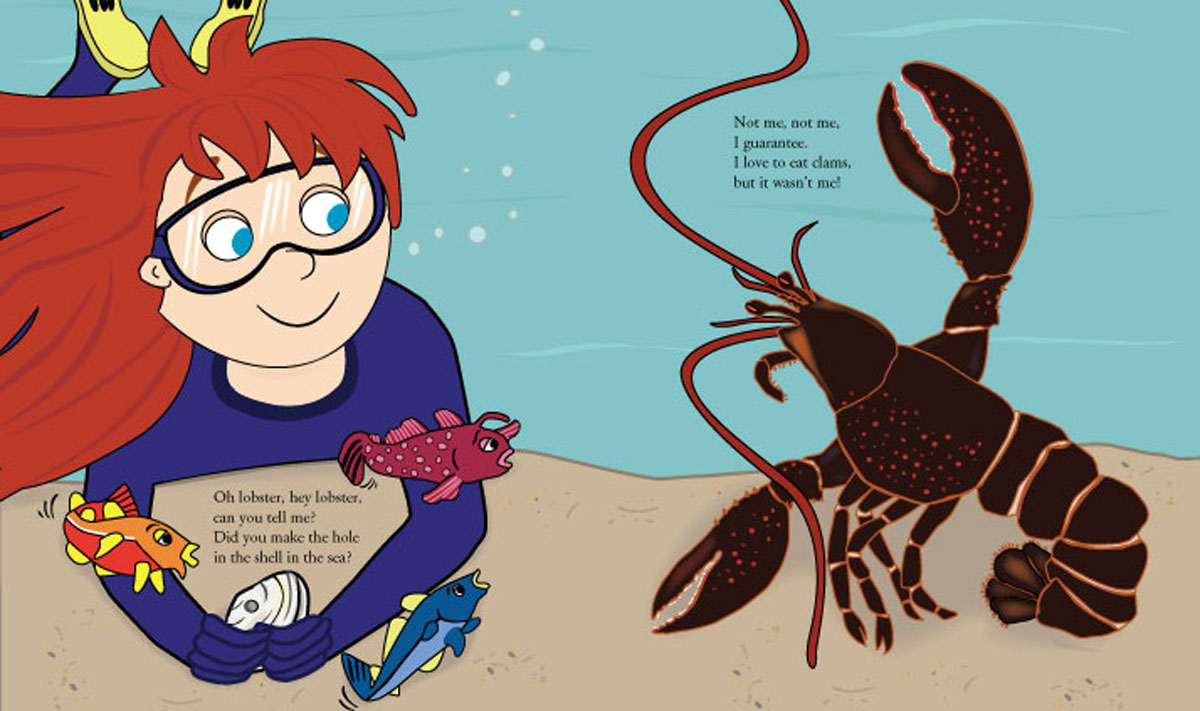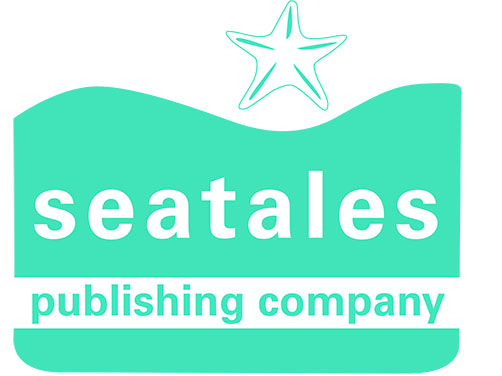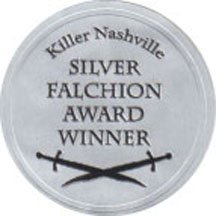
Did You Make the Hole in the Shell in the Sea?
A Whodunit of the Sea in Lilting, Rhyming Text
It’s easy to spot a shell with a neatly drilled hole as you walk along the shoreline, but do you have any idea how the hole got there? Could a shark have made this hole, or was some other sea creature responsible? Follow along as an adventurous girl seeks to discover the truth behind this mystery of the sea.
“Did You Make the Hole in the Shell in the Sea?” has rhythmic and rhyming text, and simply drawn illustrations that are brightly colored and inviting. Each expressive character helps to bring the story to life, and although the story is fictitious, all of the characters tell an authentic tale of what really happens at the edge of the sea. The repetitive text and rich vocabulary make this a fun read aloud for ages 3-10, and it’s the perfect choice for a family bedtime story. “Did You Make the Hole in the Shell in the Sea” is an entertaining choice for any classroom teacher who’s studying the sea, and searching for a fun book packed with true facts about coastal marine life, including sea stars, lobsters, moon snails, and seagulls.
Don’t miss this seaside adventure. The journey is about to begin. And the next time you find a shell at the beach with a perfectly drilled hole, you’ll know exactly what made the hole in the shell in the sea!
Winner of the Prestigious
Silver Falchion Award
Did You Make the Hole in the Shell in the Sea? has been named winner of the prestigious 2014 Silver Falchion Award, in the best children’s picture book division. “This category is for children learning to love books. Judged on a combination of originality and telling of the story, and the accompanying illustrations, the goal of this category is to identify exciting books to inspire young readers… There is rarely a murder here or a very scary monster, but there is always a mystery to solve.” This award is sponsored by Barnes and Noble and Mystery Writers of America, among others.
Moon Snails
A moon snail’s favorite foods are clams, and other bivalves. Moon snails can even be considered cannibals, because they’ve been known to eat other moon snails. They find their prey by digging and traveling under the sand. When a moon snail finds a clam to eat, it drags the clam up to the surface, where it can begin to drill. Moon snails, first, turn the clam to drill just above the hinge of the clam’s shells. It’s not known if that area is easiest to hold, or if it’s closest to most of the clam’s soft tissue beneath. Then, the moon snail pulls out its long tongue that has teeth on the end called a radula. The radula scrapes the clam’s shell like a chain saw, back and forth rapidly, until a hole is made through the shell. Next, the moon snail uses a hydraulic system to extend its tongue through the hole, and scrape and eat the clam’s soft body. When it crawls away, the moon snail leaves behind a precisely drilled hole in the shell in the sea!
Moon snails can easily be found at the beach on the tidal flats in the intertidal zone. When it’s low tide in the intertidal zone, the damp, beach sand is exposed. At high tide, that same sand is covered with salty, ocean water. The sand on the tidal flats is wet and easy to dig under, which helps the moon snail to hide and hunt. Hermit crabs, horseshoe crabs, crabs, clams, and sand dollars can be found living in the same area as moon snails. Most of these sea animals, including moon snails, can be found in deeper ocean water, too.
Moon snails are members of the Animalia Kingdom, and are invertebrates, meaning they have no backbone. They are Mollusks, and belong to the Mollusca Phylum. Mollusks are the second largest phylum, with Arthropods being the largest. Mollusks bodies are soft, and consist of three basic parts; a foot, a mantle, and a soft, non-muscular area that contains its body organs called a visceral mass. Many species, including the moon snail, have a shell made of chitin, which is formed from protein and calcium carbonate. The moon snail uses its shell for protection. The moon snail’s mantle covers its visceral mass, and has glands that produce its hard shell.
Moon snails are members of the Naticidae family, which are known for being meat eating, carnivorous snails. Members of the Naticidae family have strong shells that are indented like a navel. Naticidae have a long, retractable tube that forms part of their mouth, and a dark colored operculum, or trap door, which covers the opening of their shell.
Finally, moon snails belong to the Gastropoda Class, which are known for having a head that has sensory organs, a muscular foot, and a spiral shell. These scientific names seem to match the description of a moon snail perfectly.
The moon snail’s foot helps the moon snail to glide over the sand easily. It can be really huge, almost covering its shell, or small enough to fit inside its shell with the trap door, or operculum, closed. The size of the moon snail’s foot depends on how much the moon snail has filled its foot with seawater. The moon snail is able to expand its foot to four times the volume of its shell. The moon snail can inflate its foot very quickly, which helps it to go into and through the sand easily, removing the sand as it moves along.
American Lobsters
Because lobsters are nocturnal, they hunt at night and hide under rocks and seaweed during the day. Lobsters have a keen sense of smell and find their food with their two pairs of antennae located near their mouth, and the soft orange hairs that can be found on many parts of the lobster’s body. Although they’ve been known as scavengers, lobsters would prefer to eat fresh, live food like clams, fish, crabs, mussels, sea stars and sea urchins. If food is scarce, lobsters will even eat other lobsters.
Once a lobster has caught its food, it uses its crusher claw to hold and crack its food open. The lobster’s scissor, or pincher, claw tears the food into little pieces. A lobster uses it’s appendages in front of its mouth, called maxillipeds, to hold its food while it eats. The hairs on these appendages are so sensitive, they can distinguish different kinds of mussels. The lobster’s stomach is located close to its mouth, and the lobster’s food is chewed in its stomach by three grinding surfaces called the gastric mill.
Young American lobsters can be found living close to shore, in or near tidepools. This habitat is rich with rocks and seaweed, and provides the lobster with plenty of food and shelter. Larger lobsters move out to deeper water and sandy bottoms, and often return to the shallower, warmer waters in the summer. American lobsters, which unlike spiny lobsters, have two claws, can be found as far north as Canada, and as far south as North Carolina.
American lobsters belong to the Animalia Kingdom, and are members of earth’s largest phylum known as Arthropoda. Arthropods have jointed legs, segmented bodies, and a shell called an exoskeleton. Lobsters, like most arthropods, need to molt to grow, because their exoskeleton can’t grow with their body. Lobsters are a member of the Crustacea class, which includes crabs, shrimp, and barnacles, among others. Most crustaceans have antennae, compound eyes mounted on stalks, and three body segments. These body segments are the head, the thorax, and the abdomen, which is the lobster’s tail. The American lobster’s scientific name is Nephropidae.
It’s easy to tell a male lobster from a female one. First, the male lobster’s tail is narrower than that of a female’s of the same age. The female’s tail is wider, because she needs room under her tail to carry eggs. A female lobster will carry eggs underneath her tail for nine to twelve months. Another way to distinguish a male lobster from a female is to examine its first set of swimmerets that are closest to its body, under the tail. The male swimmerets are hard, like the shell of the lobster. The female’s swimmerets are soft and featherlike, similar to the rest of the swimmerets.
Sea Stars
Sea Stars
Sea stars are predators that have an incredible appetite for mussels, oysters, barnacles, and clams, among other sea animals. They can wipe out an entire population of bivalves if not kept in check. A sea star has a unique way of eating. Instead of bringing its food to its stomach, the sea star brings its stomach to its food. If a sea star finds a clam to eat, it will crawl on top and stick its tube feet, which have powerful suction cups, to the clam’s shell. Then a tug of war ensues, and the sea star pulls on the clam’s shells, trying to pull them apart. But the clam doesn’t want to get eaten, so it closes its shells tightly. Eventually the clam gets tired and opens its shells. Then the sea star opens its mouth, which is in the center of its body, underneath, and drops its stomach out of its mouth and into the clam to digest the soft clam body. The sea star literally turns its stomach inside out, to allow enzymes to break down the clam body. When finished eating, the sea star pulls its stomach back into its mouth, closes its mouth, and crawls away. It’s very common to find two or three sea stars devouring the same clam.
Sea stars used to be called starfish, but sea stars aren’t fish, they’re Echinoderms. They have no tail, scales, or fins like fish have. Instead, members of the Echinodermata Phylum are noted for having bodies that are radially symmetrical. That means that all body parts radiate out from a center point. The center point of a sea star contains its mouth, stomach and madreporite or sieve plate (that small orange or yellow dot on top), and its rays extend out from there. Common sea stars have five rays, but some varieties of sea stars can have up to 9-12 rays. Echinoderm is Greek for “spiny skin,” which is a perfect description for the sea star’s rough or spiny exterior. Sea stars have skeletons made of bony plates. Some of these plates have spines that can stick out a little, which gives their skin a spiny feel. Most echinoderms have hollow, tiny tube feet. Sea stars move using an hydraulic system that consists of tubes inside their bodies used to transport seawater. Most echinoderms live in the salty, ocean water, and are often seen in shallow water. Other echinoderms are sand dollars, sea urchins, and sea cucumbers.
Sea stars belong to the Animalia Kingdom, and are members of the Stelleroidea Class, and the Asteroidea Subclass. Members of the Stelleroidea Class are sea stars and brittle stars, both of which have rays extending from a central disc, not mounted on stalks. The Subclass Asteroidea contains only sea stars, whose rays aren’t distinctly separate from their body, both inside and out. Sea star rays are commonly found containing parts of their digestive and reproductive systems. This is why one ray, torn from a sea star, often has the ability to grow four more rays, allowing it to live on as an independent sea star. This process of regrowing missing body parts is called regeneration.
When examining a sea star, many people think it has one eye, that reddish-orange or beige dot on the top, center of its body. But this is a madreporite or a sieve plate, which the sea star uses to bring ocean water into its body. The madreporite is the beginning of the sea star’s vascular system that it uses to feed, move and breathe. The vascular system consists of the madreporite, the stone, ring, and radial canals, and the ampullae and podia, or tube feet. The sea star’s eyes are located on the tip of each of its rays. If a sea star has five rays, it will have five eyes. If it has nine rays, it will have nine eyes. Each eye is a simple eye, and can only distinguish shadows and light. If you look closely at the end of a sea star’s ray, you can see its tiny eyespot. It can appear black, red or beige, depending on the coloration of the sea star.
Seagulls
Seagulls
Seagulls, or herring gulls are omnivores, meaning that they eat both plants and animals. They especially enjoy eating mussels, clams, squid, fish, crabs, other birds and sea animal eggs, and insects. They aren’t fussy eaters, and when live food is scarce, they will resort to eating dead or decaying fish and animals, and even trash. Seagulls especially hang out at docks and hover over fishing vessels to find food. They usually eat their food whole, or break it apart with their beaks. If they still can’t get inside a thicker shell, they’ll drop it on a rock to shatter the shell. Once broken apart, the seagull swoops down and enjoys its meal. Seagulls commonly steal food from each other, and will dive short distances for their prey. They’ll follow whales to find fish to eat, and have been observed using bread to “fish” for fish.
Seagulls belong to the Laridae Family, which contains about 100 different bird species. Members of the Laridae Family are usually omnivores, which means they enjoy eating plants and animals. In the seagull’s case, this also can include dead or decaying fish and trash. The upper back of a Larus Argentatus, or common sea or herring gull, is usually grey, and its wing tips are most often black. They have thick bills that tend to be yellowish-orange. Their feather coloration is countershaded, with white or light under parts and darker, grayer upper parts. This helps to camouflage the seagull. A seagull’s wings are long and narrow, with a tapered shape that help it to glide effortlessly on an air current. Seagulls nest in large colonies, and are very sociable, preferring to stay in large flocks. Herring gulls average a weight of 2.5 pounds, measure about 25 inches long when full grown, and have about a 58-inch wingspan.
Seagulls pair up in early spring, and stay together for the entire breeding season. A herring gull couple will pick out a place for their nest together, making sure it’s at least 12-30 feet away from other couples nesting. To make their nest, the gull will press an indentation into the ground, and fill it with feathers, vegetation, and flotsam, which is debris that floats in and out with the tide. The female lays about three eggs that are olive or green in color, with brown and black markings. It takes about 30 days for the eggs to hatch. Chicks are born gray, with black spots, and are able to walk in about a day. Chicks will peck at their parent’s beak to access and eat regurgitated food. Chicks fledge in about 7 weeks, which means they gain feathers enough to allow them to fly. Parents feed their chicks for about 12 weeks in all. Often, the young gulls will stay with their parents for the winter. Many other young gulls will choose to form flocks and fly south in the fall. Although the adult seagulls will leave their nesting sites after their chicks are able to care for themselves, most stay year round in the same area as long as there’s open water and food available. Canadian gulls will sometimes winter in New England, and young gulls migrate south for the winter, settling on the Atlantic or the Gulf coasts.
Why Did You Make the Hole in the Shell in the Sea? Was Created
This video recorded at the beautiful Beauport Hotel in Gloucester, MA explains the origins of Did You Make the Hole in the Shell in the Sea?


